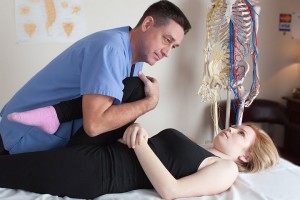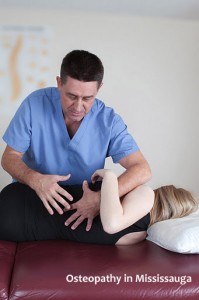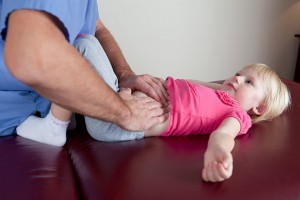Osteopathic Diagnosis and Treatment
 Dr. Still stated, “An osteopath reasons from his knowledge of anatomy. He compares the work of the abnormal body with the work of the normal body.” 1
Dr. Still stated, “An osteopath reasons from his knowledge of anatomy. He compares the work of the abnormal body with the work of the normal body.” 1
Though each osteopathic physician is unique, a typical office visit usually consists of the following elements:
- Medical history
- Physical and osteopathic structural exam
- Osteopathic medical diagnosis
- Osteopathic treatment
History
Before treatment can begin, it is important to take a thorough medical history, including a detailed description of traumatic events.
The Osteopathic Manual Practitioner is interested in understanding the body’s adaptation to adverse influences. Both trauma and illness can disturb the tissues and alter function. As the tissues twist, compress and contract – fluid continuity becomes compromised, and normal physiology is impaired. If left untreated, this altered tissue function can remain present throughout a person’s life, long after the disruptive influence has passed.
An Osteopathic History may include questions about:
- Birth
- Injuries
- Large singular impacts or strains
- Multiple small impacts or strains
- Inflammatory disease processes including prolonged high fevers
- Surgeries and residual scar tissue (adhesion)
- Dental Procedures
- Stress
- Emotional
- Physical
Structural Exam
Following the history, a medical examination is performed, which includes pertinent physical and osteopathic structural evaluations. An osteopathic practitioner learns through touch. A structural exam can be performed either sitting, standing or lying down. Wearing loose, comfortable clothing allows the osteopathic practitioner to optimally evaluate areas of bony asymmetry, tissue texture abnormalities, and fluid congestion.
The Osteopathic Manual Practitioner will typically place his hands underneath or over some part of the body. Tissue function is evaluated; the quality of motion, its balance and organization are noted.
Diagnosis
A thorough osteopathic diagnosis connects the patient’s history and physical exam to the structural evaluation. As the osteopathic practitioner places his hands upon the patient, structural dynamics are perceived, and can often be directly linked to the patient’s presenting complaint and trauma history. A “cause and effect” relationship frequently emerges, and is an essential component of the osteopathic diagnosis. Patients are frequently relieved to know that their symptoms make sense.
For example, a patient presented with a history of headaches for 5 years. She tried many forms of medical treatment without real help. A history revealed a fall down the stairs, with an injury to her tail bone, several months prior to the onset of the headaches. Her headaches were finally relieved with osteopathic treatment of the structural problems related to her tailbone injury.
Treatment

Treatment is typically gentle. Tissues are supported and allowed to change. Usually very little force is used during treatment, but at times some force may be necessary. Diagnosis and Treatment are said to blend into one another. As tissues change the physician learns more about their nature. As the nature of the tissue dysfunction is better understood, the therapeutic response deepens.
Each patient’s experience is unique. Some patients sense only a gentle touch, while others feel their body change immediately. Some patients simply feel a deep sense of relaxation, and others feel nothing at all. Most patients feel a distinct change following the treatment.
Though Osteopathy is very gentle, patients can occasionally experience some discomfort during certain stages of the treatment. When this occurs, it is simply a part of the healing process. As the treatment progresses, the discomfort subsides.
Although practitioners practicing Osteopathy in the Cranial Field will work anywhere on the body, they may find it important to diagnose and treat the head. Though styles of treatment may vary, the osteopathic practitioner will primarily focus on the body’s “mechanism”- the body’s natural striving for health and normal function.
It is The Osteopathic Practitioner duty to listen, learn, support and allow, so that an optimal state of health can be realized and experienced.
All Osteopathic Practitioners apply osteopathic principles in the treatment. The styles of treatment in which these principles are applied vary from practitioner to practitioner.
How long does it take to see results?
Results depend upon many factors. Most significant are the body’s inherent vitality (ability to heal), the severity and the duration of the problem. Some conditions will respond immediately; some will require a series of treatments. It is important to understand that Cranial Osteopathy is not a cure-all. It can benefit everyone, because everyone has been imprinted individually by the traumas of life. For some patients it might be necessary to include other types of treatment. For many, Cranial Osteopathy is “the solution” to their problems.
Visceral Osteopathy
As a subsection of osteopathy, the specialty of visceral osteopathy developed by J. P. Barral and Dr. Weisschenk deals primarily with the functionality of the internal organs (the viscera). This therapy is based on the idea that each organ has been making tiny movements since its embryonal development, and that motion can provide information about an organ’s vitality when it is palpitated. The anamnesis examines the motion of the organs in synchronicity to one another, as well as their interconnections with the supporting muscle and connective tissues. The subsequent gentle treatment relieves restrictions and strengthens ligamentous connections, the system supporting the organs in the tissue. Visceral therapy increases the vitality of the organ in question while activating the body’s self-healing powers.
Visceral osteopathy is especially good for all functional disorders of the organs. In cases where such dysfunction is suspected, I’d recommend undergoing one of these treatments as soon as possible. This therapy is both extraordinarily gentle and also able to provide complete relief, in most cases, of these dysfunctionalities after appropriate regeneration. During your treatment, I will examine the problematic organs for functionality as described above, bringing them back to their correct positions if necessary and using certain mobilization techniques to re-establish synchronicity with their sources of connection and nutrition.
Craniosacral Therapy
The growing popularity of craniosacral therapy, or craniosacral treatment, makes it seem like a new invention. But in fact it is based on a system developed over a century ago by Dr. William Sutherland using osteopathic knowledge of how the different parts of our bodies interact-our bones, tissue structures, and bodily fluids. The term combines the words cranium, for the skull, and sacrum, for the sacral bones, in recognition of the fact that the brain and spinal cord “float” in a liquid medium, the cerebrospinal fluid.
The goal of craniosacral bodywork (also abbreviated CST, for craniosacral therapy) is to bring the pulse system of the brain and the cerebrospinal fluid back into harmony.
The treatment is very gentle and subtle yet has profound effects on the body’s fundamental structures and self-healing capacity.
Baby Osteopathy
 The earlier, the better-this is especially true with respect to baby osteopathy in the treatment of dysfunctions in the human organism. Because infants’ entire rhythmic system and skeletal structures are still very flexible, and therefore unstable to a certain degree, dysfunctions caused by the birth process in particular can be cured relatively quickly and gently in this early phase of childhood. As opposed to adults, an infant’s cranial vault is not yet closed and the bones of their skulls have not yet hardened. During the birth process, the associated pressure on these areas can cause after-effects that include suckling problems, frequent vomiting after nursing or bottle feeding, long periods of crying, infant head tilt or torticolis, and problems sleeping through the night.
The earlier, the better-this is especially true with respect to baby osteopathy in the treatment of dysfunctions in the human organism. Because infants’ entire rhythmic system and skeletal structures are still very flexible, and therefore unstable to a certain degree, dysfunctions caused by the birth process in particular can be cured relatively quickly and gently in this early phase of childhood. As opposed to adults, an infant’s cranial vault is not yet closed and the bones of their skulls have not yet hardened. During the birth process, the associated pressure on these areas can cause after-effects that include suckling problems, frequent vomiting after nursing or bottle feeding, long periods of crying, infant head tilt or torticolis, and problems sleeping through the night.
Our therapy for your baby or toddler will check the rhythmic processes within the child’s system for regularity and evenness. This means early detection and treatment of most irregularities that arise and might otherwise ultimately result in the aforementioned dysfunctional blockades.
References
1. Still A.T., Osteopathy Research and Practice, Kirksville, MO, 1910, Reprinted by Eastland Press, 1992, p7
Copyright © 2005-2011 The Cranial Academy, Inc.
